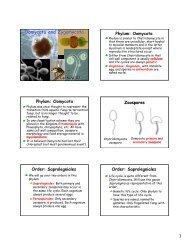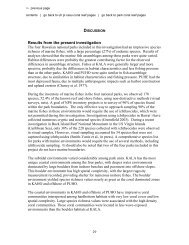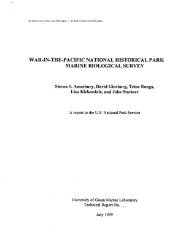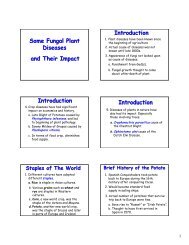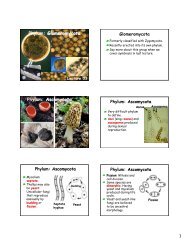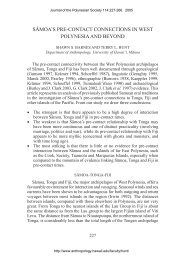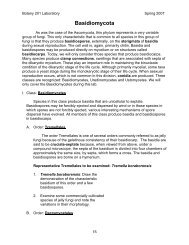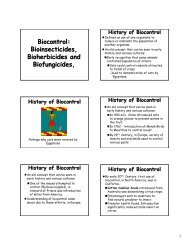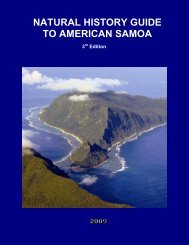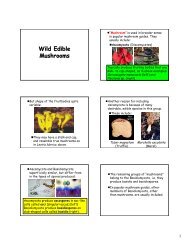american samoa - University of Hawaii at Manoa Botany Department
american samoa - University of Hawaii at Manoa Botany Department
american samoa - University of Hawaii at Manoa Botany Department
- No tags were found...
Create successful ePaper yourself
Turn your PDF publications into a flip-book with our unique Google optimized e-Paper software.
Improved channeliz<strong>at</strong>ion <strong>of</strong> stormw<strong>at</strong>er flows is needed to help reduce potential damages toresidential and commercial property in the village. Following higher rainfall events, surfacestormw<strong>at</strong>er flows upland <strong>of</strong> the village has repe<strong>at</strong>edly spread over much <strong>of</strong> the upland portion<strong>of</strong> the inhabited village area. As a result, various homes in the upland village area have beenflooded. The capacity <strong>of</strong> the lower portion <strong>of</strong> Vailoa Stream is inadequ<strong>at</strong>e to accommod<strong>at</strong>elarger stormw<strong>at</strong>er flows. The lower stream channel has likely been altered over the years toaccommod<strong>at</strong>e gradual residential expansion in the upland village area. In addition, the presentblockage <strong>of</strong> the lower stream channel increases the areal extent <strong>of</strong> potential flooding andproperty damage resulting from a 100-year storm and less severe storm events.Construction <strong>of</strong> a second upland channel would help allevi<strong>at</strong>e present flooding in the uplandarea and, <strong>at</strong> the same time, enable the transport <strong>of</strong> stormw<strong>at</strong>er flows to the wetland. Onedesirable use <strong>of</strong> the Tula wetland would be stormw<strong>at</strong>er detention. Restor<strong>at</strong>ion <strong>of</strong> this wetlandfunction would help reduce the amount <strong>of</strong> sediment<strong>at</strong>ion th<strong>at</strong> can be gener<strong>at</strong>ed from VailoaStream. Stormw<strong>at</strong>er detention would also permit the tre<strong>at</strong>ment and recharge <strong>of</strong> stormw<strong>at</strong>er intothe fringe <strong>of</strong> the basal aquifer.WETLAND VEGETATIONNovember 1999 SurveyArt Whistler <strong>of</strong> Isle Botanica conducted a botanical survey <strong>of</strong> the Tula wetland on November 2and 17, 1999. Mr. Whistler was part <strong>of</strong> a three-person field survey team organized by PedersenPlanning Consultants th<strong>at</strong> observed wetland veget<strong>at</strong>ion, habit<strong>at</strong> for aqu<strong>at</strong>ic fish andinvertebr<strong>at</strong>es, stream hydrology, as well as land uses within and adjacent to the wetland. Hisobserv<strong>at</strong>ions are summarized in the following paragraphs.West Side <strong>of</strong> Vailoa StreamVeget<strong>at</strong>ion observed within the Tula wetland along the west side <strong>of</strong> Vailoa Stream was notrepresent<strong>at</strong>ive <strong>of</strong> a wetland. Veget<strong>at</strong>ion along the stream banks represented a mixture <strong>of</strong> typicalwetland or wetland margin plants such as Coix lacryma-jobi sanasana (Job’s tears), Paspalumconjug<strong>at</strong>um vao lima (T-grass), and more typical upland species such as Nephrolepis hirsutulavao tuaniu (sword fern). A few Hibiscus tiliaceus fau (beach hibiscus) and Barringtoniasamoensis falaga were also evident along the stream banks.Southwest <strong>of</strong> the Primary Shoreline RoadwayA fresh-w<strong>at</strong>er swamp domin<strong>at</strong>ed by beach hibiscus and a trough <strong>of</strong> highly disturbed marsh wasobserved southwest <strong>of</strong> a recent fill area. The fill area is immedi<strong>at</strong>ely adjacent to the southwestside <strong>of</strong> the primary shoreline roadway.The highly disturbed marsh is situ<strong>at</strong>ed in the northwest part <strong>of</strong> the wetland. The marsh isdomin<strong>at</strong>ed by T-grass and somewh<strong>at</strong> less amounts <strong>of</strong> California grass and mauutoga(commelina). Considerably less amounts <strong>of</strong> weeds, such as Kyllinga nemoralis, tropicalcupgrass, Phyllanthus amarus, and three-flowered beggarweed were also evident in the marsh.All <strong>of</strong> the plants observed in this area represented introduced plant species. The only n<strong>at</strong>iveherb recorded during the survey was selesele (Mariscus javanicus) th<strong>at</strong> comprised only a fewclumps <strong>at</strong> the south end <strong>of</strong> the marsh.American Samoa Wetland/Stream Restor<strong>at</strong>ion and Enhancement PlanFebruary 2001, Tula Wetland, Page 2-5



